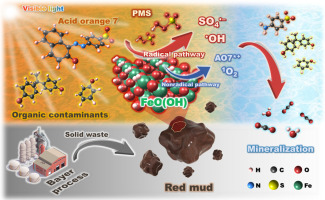Publication
Advanced Redox Technology Lab
Publication
Advanced Redox Technology Lab
Journal papers
A dye-sensitized photocatalysis system was developed for degrading persistent organic contaminants using solid waste (i.e., red mud, RM) and peroxymonosulfate (PMS) under visible light. Complete degradation of acid orange 7 (AO7) was achieved in RM suspension with PMS, where the co-existence of amorphous FeO(OH)/α-Fe2O3 was the key factor for PMS activation. The experimental results obtained from photochemical and electrochemical observations confirmed the enhanced PMS activation due to the Fe-OH phase in RM. DFT calculations verified the acceleration of PMS activation due to the high adsorption energy of PMS on FeO(OH) and low energy barrier for generating reactive radicals. Compared to the control experiment without AO7 showing almost no degradation of other organic contaminants (phenol, bisphenol A, 4-chlorophenol, 4-nitrophenol, and benzoic acid), photo-sensitized AO7* enhanced electron transfer in the FeIII/FeII cycle, dramatically enhancing the degradation of organic contaminants via radical (•OH, SO4•−, and O2•−) and non-radical (dye*+ and 1O2) pathways. Therefore, the novel finding of this study can provide new insights for unique PMS activation by heterogeneous Fe(III) containing solid wastes and highlight the importance of sensitized dye on the interaction of PMS with Fe charge carrier for the photo-oxidation of organic contaminants under visible light.
